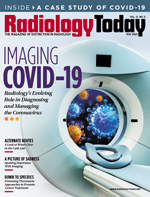 Editor’s Note: Taking On a New Role
Editor’s Note: Taking On a New Role
By Dave Yeager
Radiology Today
Vol. 21 No. 5 P. 4
Although progress is being made against COVID-19, there is, at least at the time of this writing, a long way to go. Scientists and health care professionals are learning more about the disease each day, but it will take painstaking work to unravel its mysteries. Medical imaging has a role to play in that work—the exact role is still open to debate—but early research indicates that CT and chest X-ray imaging may help track disease progression and diagnose secondary infections.
This month’s cover story looks at potential uses of CT and X-ray in the treatment of COVID-19. Although imaging is not currently recommended as a screening tool for the disease, it may be useful for following patients who have severe cases. Beth W. Orenstein reviews recent research and guidelines.
Also in this issue, Kathy Hardy reports on attempts to find imaging markers of depression. Although it is recognized as a biological condition, depression has historically been challenging to describe with medical imaging. Recent advances, however, have opened the door to more accurate identification of brain states and treatment responses.
If you’re wondering what’s new in the interventional arena, Keith Loria has a rundown of the newest features available in the catheterization lab. As minimally invasive techniques are refined, demand for interventional procedures will grow.
Demand for targeted treatments is also increasing. Dan Harvey has an update on some promising theranostic approaches to prostate cancer treatment. Prostate cancer, which is one of the most common types, can be difficult to treat. Harvey has a round-up of some therapies that better target the disease and may allow physicians to tailor treatment to specific cases.
Finally, we’ve started a COVID-19 group on our Facebook page, where we’ll regularly be posting related content and sharing the latest news. Please join us.
Enjoy the issue, and stay safe.

